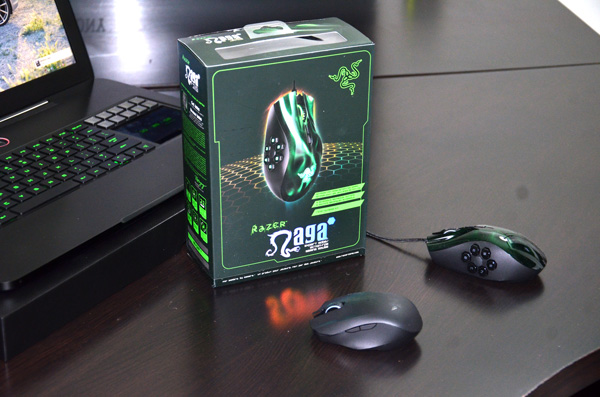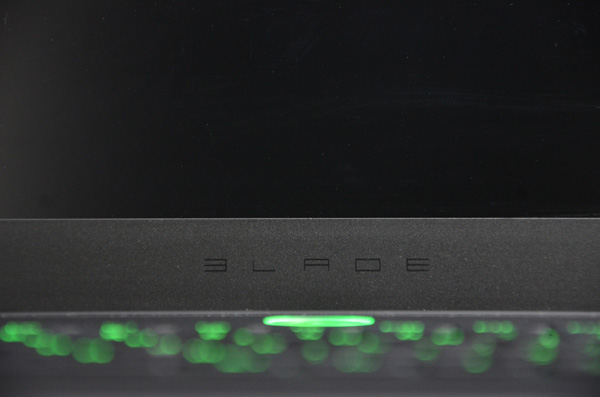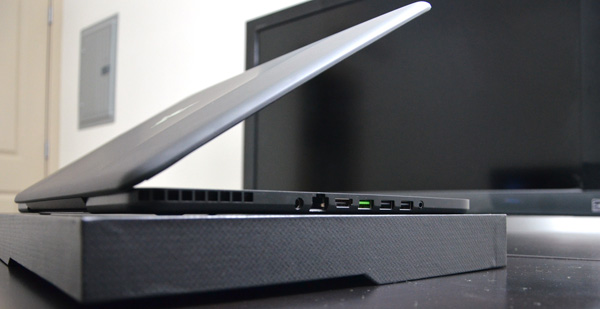The Razer Blade Review
by Vivek Gowri & Jarred Walton on March 15, 2012 3:01 AM ESTRazer is, first and foremost, a gaming company. From the company slogan (“By gamers, for gamers”), to partnerships with a number of the most popular game development studios, even the job title on the CEO’s business card (it reads Chief Gamer), nothing about Razer is shy about who the target market is. But it’s key to note that Razer is a gaming company which has focused on gaming-related peripherals and accessories—mice, keyboards, headsets, controllers, and limited edition peripherals for specific games. But that all changes as of now.
The vessel of change in question: Razer’s new Blade, a $2799 gaming laptop that bucks almost all of the common trends in gaming-focused desktop replacements. This isn’t the first time that Razer has shown intent to play in the gaming hardware space, having shown off the innovative Switchblade concept system at CES 2011. The Switchblade design concept clearly had a major influence on the Blade as is evident from the Switchblade UI panel on the side of the keyboard, but what’s important to note with the Blade is that it shows just how serious Razer is about transitioning into PC hardware and gaming systems. Read on to see how it fared.
| Razer Blade Specifications | |
| Processor |
Intel Core i7-2640M (2x2.80GHz + HTT, Turbo to 3.5GHz, 32nm, 4MB L3, 35W) |
| Chipset | Intel HM67 |
| Memory | 2x4GB DDR3-1333 |
| Graphics |
NVIDIA GeForce GT 555M 2GB GDDR5 (144 CUDA Cores, 675MHz/1350MHz/2.5GHz core/shader/memory clocks, 128-bit memory bus) |
| Display |
17.3" LED Matte 16:9 1080p AUO B173HW01 V5 |
| Hard Drive(s) | 256GB Lite-On LET-256M2S 6Gbps SSD |
| Optical Drive | - |
| Networking |
Intel Centrino Advanced-N 6230 802.11a/b/g/n Bluetooth 3.0 |
| Audio |
Realtek ALC275 HD Audio Stereo speakers Single combination mic/headphone jack |
| Battery | 6-Cell, 60Wh (integrated) |
| Front Side | - |
| Right Side | Kensington Lock |
| Left Side |
AC Adaptor Port Gigabit Ethernet HDMI USB 3.0 2 x USB 2.0 Headphone/Line-in Combo |
| Back Side | - |
| Operating System | Windows 7 Home Premium 64-bit SP1 |
| Dimensions |
16.81" x 10.90" x 0.88" (WxDxH) 427mm x 277mm x 22.4mm |
| Weight |
6.4 lbs 2.91kg |
| Extras |
2.0MP Webcam Ambient light sensor Backlit keyboard Switchblade UI Ten dynamic LCD keys 4.05" WVGA LCD touchpad (capacitive, multitouch) |
| Warranty | 1-year limited |
| Pricing | $2799 |
Heralded by Razer as the “World’s First True Gaming Laptop”, the 17” Blade is built around Intel’s Core i7-2640M and an NVIDIA GT 555M dGPU. The i7 is clocked at 2.8GHz, with a max turbo of 3.3GHz on two cores or 3.5GHz on a single core, while the GT 555M has 2GB of vRAM and clocks of 675/1350/2500 MHz for core, shaders, and vRAM, respectively. The GPU is pretty pedestrian by 17” gaming notebook standards, with the GT 555M falling somewhere between high-end mainstream and low-end gaming cards. There’s many different versions of the GT 555M, but the SKU in the Blade seems to be the most potent variant, using a cut down version of the same GF116 architecture in the GTX 560M. The rest of the specsheet is headlined by 8GB of memory and a 256GB SSD made by Lite-On. The Lite-On LET-256M2S is built around Marvell’s 88SS9174 controller, the same controller that serves as the basis for Intel’s SSD 510. Lite-On claims up to 480MB/s for sequential read and 330MB/s for sequential write speeds. The display is a 17.3” 1080p panel made by AU Optronics, but what we were most thrilled by is the beautiful matte screen finish. The Switchblade UI panel lives to the right of the keyboard and features 10 dynamic LCD keys (Art Lebdev-style) as well as a secondary display, a 4.05” 800x480 multitouch LCD that serves as the Blade’s touchpad. In addition, Razer includes a special edition of their Bluetooth mobile gaming mouse, the Orochi.
Rather impressively, Razer managed to pack all that hardware into an enclosure that’s just 0.88” thick and weighs 6.4lbs. If Intel were to extend the ultrabook hardware guidelines out to 17” notebooks, the Blade would hit them pretty dead on. The razor-thin (get it, get it?) profile explains why Razer was limited to a GT 555M—simply put, Razer couldn’t fit anything more powerful into the thermal design without significantly compromising the performance of the cooling system. But what’s noteworthy here is that Razer took the design of the Blade in completely the opposite direction of the majority of the gaming notebook world.
If you were to poll a large group of people for the best 17-18” gaming class portable on the market, you’d end up with a range of answers—Alienware’s M17x or M18x, the ASUS G74Sx, some variant of Clevo’s P170HM, possibly the MSI GT780, etc.
| Razer Blade | Alienware M17x R3 | Alienware M18x | ASUS G74SX | Clevo P170HM | MSI GT780-DXR | |
| CPU | Core i7-2640M | Core i7-2670QM | Core i7-2670QM | Core i7-2670QM | Core i7-2670QM | Core i7-2670QM |
| GPU | GT 555M | HD 6990 | GTX 560M SLI | GTX 560M | GTX 580M | GTX 570M |
| Thickness | 0.88" | 1.76" | 2.13" | 0.82-2.44" | 1.65-1.89" | 2.17" |
| Weight | 6.40lbs | 9.39lbs | 11.93lbs | 9.42lbs | 8.60lbs | 8.63lbs |
| Price | $2799 | $2049 | $2899 | $1399 | $2239 | $1699 |
Take a look at the spec table—the Blade is thinner than everything up there by at least a factor of two, as well as being at least two pounds lighter. It’s also a good deal more expensive than everything but the M18x, and a good deal less powerful. (It's worth noting that the Blade is the only one on the list with an SSD, but otherwise they're pretty similar—1080p, 8-12GB memory, etc. Factor an additional $200 to upgrade to an SSD in the other systems.) Comparing the M18x and the Blade head to head is a bit of comedy—in terms of form factor, the Blade is literally half the laptop the nearly twelve-pound M18x is. They’re both very high-end and very expensive gaming notebooks, but they couldn’t be any more different after that.
So it’s pretty clear that Razer wasn’t aiming at the gaming notebook establishment—in fact, on paper the Blade looks a bit like the Windows answer to the 17” MacBook Pro. Which isn’t to say that the 17” MBP is a competitor for the Blade in any way—the design ethos and target markets are completely different, but it’s worth noting the similarities in form factor and price, as well as the focus on premium design and overall attention to detail. In the PC world, the closest you’re going to get on paper is the HP ENVY 17, at 1.28” thick, 7.37lbs, and starting at $1249 with AMD Radeon HD 7690 XT graphics.
Where I’m going with all this is to show that the Blade is a pretty unique proposition in the notebook world—it’s a high-end 17” gaming portable that, at least in terms of hardware, focuses more on the portable than the gaming.













95 Comments
View All Comments
ezmo85 - Thursday, March 15, 2012 - link
This sort of reminds me of the launch of the original iPad:-very well built
-sleek and stylish
-extreme attention to and focus on optimization for use-case
-potential trend setter for a new category of computing
But there is one key difference that will prevent the Razer Blade from reaching anywhere near the iPad's success: pricing.
When the iPad launched, people were estimating it would land in the $1000+ range, which Apple very well could have done (especially given their record up to that point), dooming it to a small, niche market. Instead the pricing started at half that, and now 2 years later no one can deny its overwhelming success--even in the mainstream. In the case of the Razer Blade, I'm afraid this will remain a niche product until they can drastically lower the price.
I personally would love to own a Razer Blade; it would be the perfect compliment to my overpowered desktop. When I'm on the go I don't need the video settings cranked to the max, I just want the games to be playable, and the computer itself to be... well, a laptop. Something comfortable to carry around, with enough battery life to get me through a plane ride, coffee shop browsing session, class or two of note-taking, etc. This product meets that use case quite well, and I don't think I'm alone in these desires.
But there's no way I'm spending upwards of $3000 for this. Even on a higher-than-average salary, I just can't afford that. Cut that price by half... or even, dare I say, 2/3? At $1500, I'd be hard pressed not to at least make it a near-future purchase. At $1000, I'd buy it today (if the wife let me).
But I know those prices are pipe dreams... for now.
Anchen - Thursday, March 15, 2012 - link
Isn't this in a lot of ways like a Macbook pro, with some interesting design ideas? If this wasn't marketed as a "true gaming laptop" but just as a high end laptop I wonder what people's comments would be. Especially if say Apple was the one making these ideas. On a minor note, I would love the function key to be on the right side of my keyboard personally. I personally don't use it much , and if I do it's to fiddle with brightness, or to swap what the video is going out to. In other words it's something I don't mind digging a second for as opposed to touching by accident while gaming instead of ctrl.That said at it's price range it's not a product I'd buy, same for the macbook pro. Switchblade is neat but ultimately I think if they saved some money with a normal trackpad there they probably would have been better served. I really do like the design and aesthetic though.
Malih - Thursday, March 15, 2012 - link
I always wonder when there will ever be a 15" or 17" laptop with consumer-respecting display resolution that are THIN and have good design will come out. And here's one, it's gaming grade laptop too.I won't mind spending a bit over $2,500 for it (that is if I have the money to spare, which I don't right now, but if I do), I'd grab this laptop right away, that's how desirable it is... for me, cause I always respect a good display coupled with good design.
assmode - Thursday, March 15, 2012 - link
really, $2700 for this?a fancy lighted computer and a lcd touch pad.
sorry but that's a subpar computer with a low end graphics card, does it even have an SSD ?
Go with msi GT783, its got a nVidia GTX580m, 16gigs of ram and 256gb SSD in it atleast and for 500$ less.
assmode - Thursday, March 15, 2012 - link
and of course much better cpu.and going by the table here in the intro page, the GT780 is a much better deal than a lesser Alienware, lmao.
ThreeDee912 - Thursday, March 15, 2012 - link
People keep throwing out specs and prices, but the GT783 is over 2" thick and almost 9lbs.This isn't a desktop replacement, this is meant to actually be portable, not a semi-portable slab.
KoolAidMan1 - Thursday, March 15, 2012 - link
The 17" Macbook Pro costs less, has a faster GPU, all while still managing a slim chassis and excellent battery life.When a 17" MBP, a professional laptop that is excessive even among the Macbook Pro line, can beat the Razer Blade in specs and price then you know something is off.
Malih - Friday, March 16, 2012 - link
Now that I think about it, you're absolutely right. The only plus is the touchpad, which is not really a plus for me.ananduser - Friday, March 16, 2012 - link
No KooldAidMan, it's not about the specs, its the "experience"; you should understand that. MB cannot offer you what this Blade can, while the Blade can offer the mundane computing of a MB.ameetkumarmaharana - Thursday, March 15, 2012 - link
My budget is Rs.1,00,000 INR. Which laptop should I go for? Please suggest the best one within the price range.